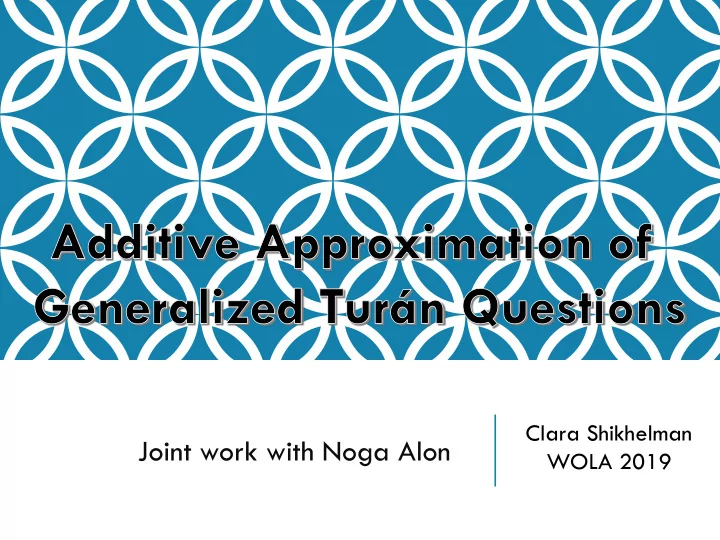

Clara Shikhelman Joint work with Noga Alon WOLA 2019
GRAPH MODIFICATION For an input graph 𝐻 find the minimum possible number of edges/vertices we need to add/remove/edit to get a graph with given property.
INTRO NP-HARD EDGE MODIFICATION PROBLEMS Yannakakis ‘81 being outerplanar, transitively orientable, and line-invertible. Asano and Hirata ‘82, Asano ’87 Certain properties expressible by forbidding minors or topological minors. Natanzon, Shamir and Sharan ‘01 Hereditary properties such as being Perfect and Comparability.
INTRO APPROXIMATION OF EDGE MOD PROBLEMS Fernandez de la Vega ‘96, Arora, Frieze and Kaplan Arora, Karger and Karpinski ‘02 Quadratic assignment ‘95 several NP-complete problems and other problems such as MAX-CUT Alon, Vega, Kannan and and MAX-3-CNF Karpinski ‘02 Constraint- Frieze and Kannan ‘99 Satisfaction-Problem Graph theo. properties
INTRO SOME DEFINITIONS A graph property is called monotone if it can be defined by forbidding a family of graphs. The only relevant edge modification for monotone properties is edge deletion. For a graphs 𝐻, 𝑈 and a family of graphs ℱ let 𝑓𝑦(𝐻, 𝑈, ℱ) be the maximum possible number of copies of 𝑈 in an ℱ -free subgraph of 𝐻 .
INTRODUCTION 𝑓𝑦(𝐻, 𝐿 2 , ℱ) Alon, Shapira and Sudakov ’05 For any 𝜗 > 0 and ℱ there is a polynomial time algorithm that approximates 𝑓𝑦(𝐻, 𝐿 2 , ℱ) up to an additive error of 𝜗𝑜 2 . A significantly ( 𝑜 2−𝜗 ) better approximation is possible iff there is a bipartite graph in ℱ .
ALGORITHM FOR GENERAL 𝑈 Alon, Sh. ‘18+ For any graph 𝑈 , finite family of graphs ℱ and 𝜗 > 0 there is a polynomial time algorithm that approximates 𝑓𝑦(𝐻, 𝑈, ℱ) up to an additive error of 𝜗𝑜 𝑤 𝑈 . Can we do better?
CAN WE DO BETTER? 𝓒 𝑼 - The family of blow ups is all the graphs obtained from 𝑈 by replacing vertices with independent sets and every edge with complete bipartite graph. Proposition (Alon, Sh. ‘ 18+) Let 𝑈 be a graph and ℱ a family of graphs s.t. there is a graph 𝐼 ∈ ℱ ∩ ℬ(𝑈) . Then 𝑓𝑦 𝐻, 𝑈, ℱ can be calculated up to an additive error of 𝑜 𝑤 𝑈 −𝑑(𝑈,ℱ) in polynomial time.
CAN WE DO BETTER? Conjecture It is NP-hard to approximate 𝑓𝑦(𝐻, 𝑈, ℱ) up to an additive error of 𝑜 𝑤 𝑈 −𝜗 iff ℱ ∩ ℬ 𝑈 = ∅ . Proved for: 1. Both 𝑈 and ℱ are complete graphs 2. Both 𝑈 and ℱ are 3-connected, NP-hard up to an additive error of 𝑜 𝑤 𝑈 −2−𝜗 3. In progress – additive error of 𝑜 𝑤 𝑈 −𝜗
INTUITION FOR THE ALGORITHM REGULAR PAIRS Given a graph 𝐻 and a pair of disjoint sets 𝑊 2 , 1 , 𝑊 we say that (𝑊 2 ) is an 𝝑 -regular pair if for 1 , 𝑊 every 𝑉 𝑗 ⊆ 𝑊 𝑗 s.t. 𝑉 𝑗 > 𝜗|𝑊 𝑗 | 𝑒 𝑊 𝑗 , 𝑊 𝑘 − 𝑒 𝑉 𝑗 , 𝑉 ≤ 𝜗 𝑘 𝑓 𝑊 𝑗 ,𝑊 𝑘 Where 𝑒 𝑊 𝑗 , 𝑊 𝑘 = 𝑊 𝑗 ⋅|𝑊 𝑘 |
INTUITION FOR THE ALGORITHM REGULAR PARTITIONS 𝑙 For a graph 𝐻 , a partition of its vertices 𝑊 = 𝑉 ∪ 𝑗=1 𝑗 is called 𝑊 strongly 𝝑 -regular if 𝑉 𝑊 1. For every 𝑗, 𝑘 𝑊 𝑘 | and 𝑉 < 𝑙 𝑗 = |𝑊 𝑙 𝑒 1𝑙 𝑊 1 𝑒 1𝑗 𝑒 12 𝑊 𝑗 2. Every pair 𝑊 𝑘 is 𝜗 -regular 𝑗 , 𝑊 𝑊 2 Can be found in pol-time by changing 𝑝(𝑜 2 ) edges.
INTUITION FOR THE ALGORITHM CONVENTIONAL SUBGRAPH A conventional subgraph of 𝐻 if it is obtained by deleting 1. All of edge inside the sets 𝑊 𝑉 𝑗 𝑊 𝑙 𝑒 1𝑙 𝑊 1 𝑒 1𝑗 2. All of the edges with endpoint in 𝑉 𝑒 12 𝑊 𝑗 𝑊 2 3. All of the edges between some (𝑊 𝑗 , 𝑊 𝑘 ) 𝑉 𝑊 How many conventional subgraphs are there? 𝑙 𝑒 1𝑙 𝑊 1 0 𝑒 12 𝑊 𝑗 𝑙 𝑊 2 2 2
THE (SIMPLE) ALGORITHM For a graph 𝑈 , a finite family of graphs ℱ and input graph 𝐻 : 1. Find a strong 𝜗 -regular partition of 𝐻 . 2. Find a conventional subgraph of 𝐻 which is ℱ -homorphism-free and has max. possible 𝑈 density. Main Lemma This graph has ≥ 𝑓𝑦 𝐻, 𝑈, ℱ − 𝜗𝑜 𝑤 𝑈 copies of 𝑈 .
THANKS FOR YOUR ATTENTION! 𝑉 𝑉 𝑊 𝑊 𝑙 𝑙 𝑒 1𝑙 𝑒 1𝑙 𝑊 𝑊 1 1 0 𝑒 1𝑗 𝑒 12 𝑒 12 𝑊 𝑊 𝑗 𝑗 𝑊 𝑊 2 2
Recommend
More recommend